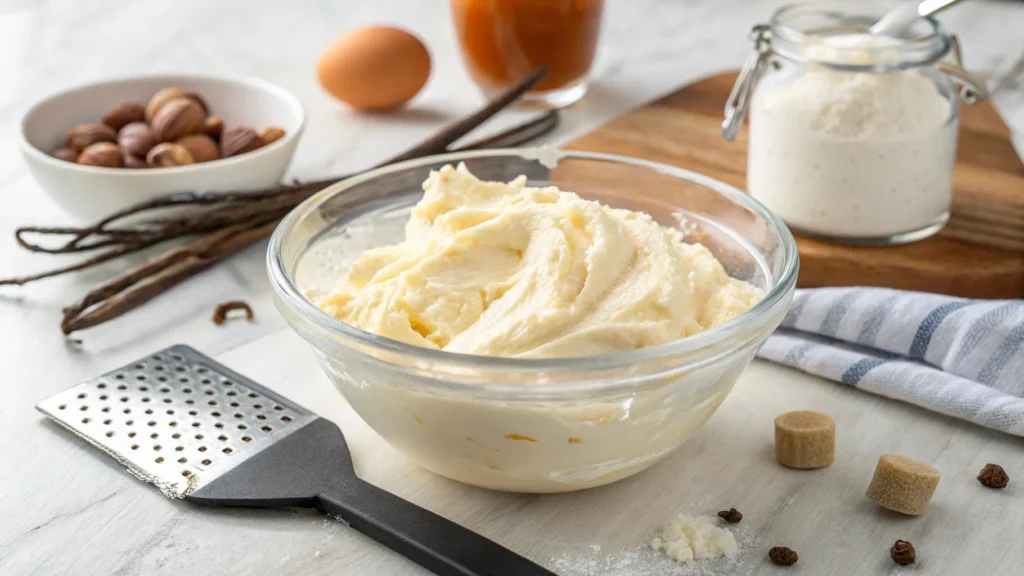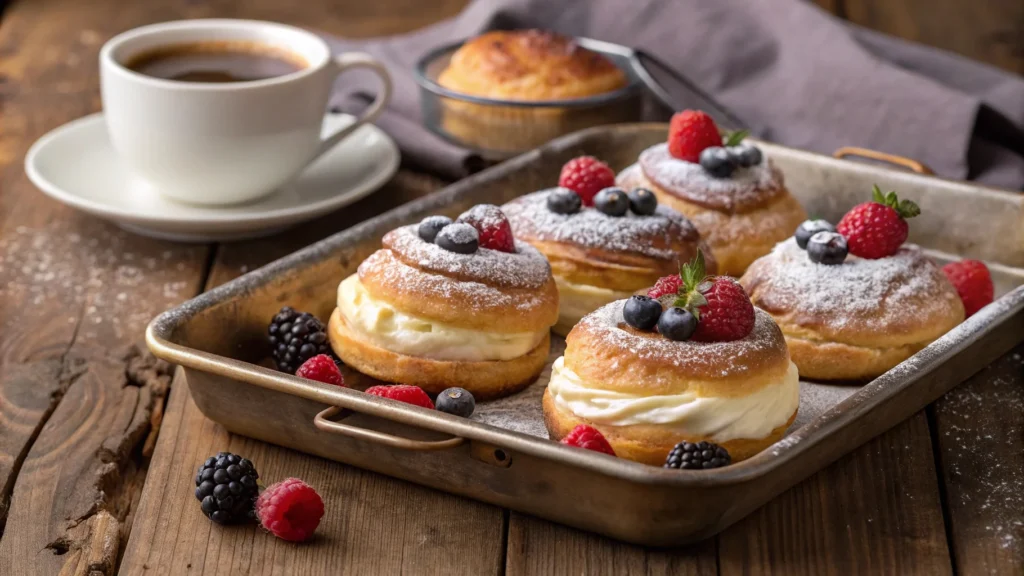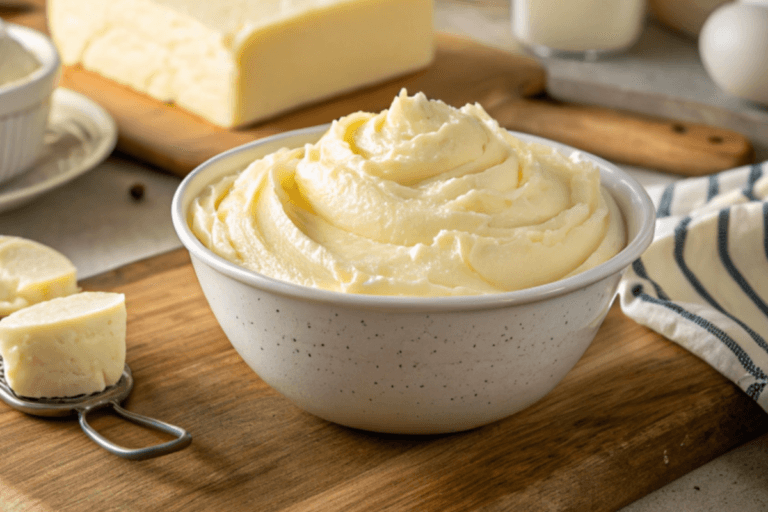The cream cheese filling is a timeless kitchen essential celebrated for enhancing flavor and texture. This versatile mixture remains a favorite among home cooks and professional chefs, perfect for desserts, savory pastries, or a standalone dip. By understanding the key elements of this creamy delight, you can Elevate your cooking to create dishes that impress and satisfy. This article examines every aspect of cheese filling, from its ingredients to its applications, ensuring you can master this essential kitchen component.
Table of Contents
What is Cream Cheese Filling?
This rich filling is a luscious blend of cream cheese and complementary ingredients to achieve a specific texture and flavor profile. It is often associated with desserts and is a fantastic addition to savory creations. Its rich and slightly tangy flavor makes it an excellent choice for various culinary applications. This mixture can be sweetened with sugar or honey for desserts or Boosted with herbs and spices for savory dishes.
A primary characteristic of this filling is its smooth and spreadable consistency. This feature makes it ideal for layering, piping, or spreading. Additionally, its ability to hold its shape under various conditions further increases its versatility in hot and cold dishes.
The Versatility of Cheese Filling
Cream cheese filling stands out due to its adaptability in the kitchen. Its wide-ranging applications make it a favorite in both sweet and savory recipes. Below are some common uses:
- Desserts: Cheesecakes, cupcakes, and Danish pastries.
- Savory Dishes: Stuffed pasta like ravioli or as a base for dips.
- Frostings: A classic choice for carrot cake or red velvet cake.
- Fillings for Pastries: Improves puff pastries or croissants with creamy richness.
This versatility stems from the cream cheese’s unique flavor profile, which balances tanginess and creaminess. Adjusting its accompanying ingredients allows you to customize the filling to suit various recipes. Cream cheese filling adapts beautifully when adding fruit puree for a fruity touch or garlic and dill for a savory twist.
Ingredients Of Cream Cheese Filling
Creating the best cream cheese filling starts with using fresh, high-quality ingredients. Each adds flavor and texture, making the filling just right. The key ingredients include:
- Cream Cheese: The star ingredient, offering the base texture and flavor.
- Sweeteners: Powdered sugar or honey for sweetness.
- Flavor Improvers: Vanilla extract for desserts or herbs for savory versions.
- Binding Agents: Heavy cream or sour cream for smoothness and structure.
Optional additions like lemon zest, cocoa powder, or spices can help tailor the filling to specific recipes. Always use fresh, high-quality ingredients to improve the cream cheese filling’s flavor so that it remains vibrant.
For hearty recipes that pair well with this filling, refer to this article on making the perfect hashbrown casserole, where creamy layers can be a delicious addition.
Step-by-Step Guide to Making Cream Cheese Filling
Preparing this straightforward filling is quick and requires just a handful of essential ingredients. Follow these simple steps to create a rich and deliciously smooth mixture:
- Prepare the Ingredients: Soften the cream cheese by leaving it at room temperature for 30 minutes.
- Gather all other ingredients, ensuring they are measured accurately.
- Mix the Base: Beat the cream cheese using a hand or stand mixer until smooth.
- Add sweeteners and continue mixing until fully incorporated.
- Add Flavoring: Gradually mix in vanilla extract or other flavor Improvers.
- For savory fillings, incorporate herbs and spices at this stage.
- Adjust the Consistency: Slowly add heavy or sour cream to achieve the desired texture.
- Chill and Use: Cover and refrigerate for at least 30 minutes before use.

By following these steps, you’ll Improve the smoothness, flavor, and readiness of your cream cheese filling for any recipe.
Common Mistakes and How to Avoid Them
While cream cheese filling is simple, a few common mistakes can impact its quality. Here’s how to avoid them:
- Using Cold Cream Cheese: Always soften the cream cheese before mixing to prevent lumps.
- Mixing too much: Stirring the mixture too long can make it runny.
- Too much sweetness: Add enough sugar to balance the flavor without covering up the tangy taste.
- Skipping Chilling: Chilling allows the flavors to meld and the filling to set correctly.
By paying attention to these details, your cream cheese filling will consistently achieve the ideal consistency and flavor.
Popular Recipes Using Cream Cheese Filling
This creamy delight is a key ingredient in many classic recipes loved by all. Here are some popular choices:
- Classic Cheesecake: A decadent, creamy dessert with a graham cracker crust.
- Red Velvet Cake: Layers of moist cake paired with tangy cream cheese frosting.
- Stuffed French Toast: Bread slices filled with sweetened cream cheese and topped with syrup.
- Savory Stuffed Mushrooms: Button mushrooms filled with a savory cream cheese mixture and baked to perfection.

Customizing Your Cream Cheese Filling
Cream cheese filling is a flexible ingredient used in many recipes and flavors. Depending on your needs, you can make it sweet, savory, or tangy. Adding sugar or honey makes it sweeter, perfect for desserts like cupcakes and cinnamon rolls. Mix garlic, herbs, or spices for savory options to create a tasty filling for snacks and sandwiches.
For a smoother texture, mix the filling with heavy cream or yogurt. This is ideal for layered cakes or mousse that need a lighter touch. If you want a thicker filling, add mascarpone or ricotta, which works well for stuffing pastries or pies.
- Add fruit purees or zest for a fruity twist.
- Incorporate a splash of vanilla or almond extract to infuse the filling with a delightful flavor.
- For a chocolate twist, mix in some cocoa powder.
Trying these adjustments helps you create a cream cheese filling that matches your recipe needs. Using organic cream cheese can also give it a fresh and rich flavor.
For ideas on incorporating cream cheese into your meals, check out this recipe for pickle pie pizza. Cream cheese can provide a creamy base or topping that complements bold and tangy flavors.
Storage and Shelf Life of Cream Cheese Filling
Ensuring the longevity of your cream cheese filling demands attention to proper storage methods, subtly guarding its freshness and retaining its impeccable quality. Since cream cheese is a dairy product, it should be refrigerated below 40°F (4°C). Store it in an airtight container to prevent exposure to moisture and other odors.
Homemade cream cheese filling typically lasts up to one week in the refrigerator. At the same time, store-bought varieties may have a longer shelf life due to added preservatives. Always check the expiration date on pre-packaged cream cheese before use. The filling is tightly sealed to prevent freezer burn and maintain its creamy texture if freezing. Frozen cream cheese filling can last up to two months but may require thorough mixing after thawing to restore its smoothness.
Tips for extending freshness:
- Store the filling in the coldest area of the fridge.
- Use clean utensils to prevent contamination.
- Label containers with the date to keep track easily.
By following these tips, your cream cheese filling will stay fresh and ready to use. Splitting it into smaller portions before freezing makes it easier to use single servings when needed.
Nutritional Insights of Cream Cheese Filling
Understanding the nutritional profile of cream cheese filling is crucial for those mindful of their dietary intake. Cream cheese is rich in saturated fats, making it calorie-dense. However, it also contains beneficial nutrients like calcium and vitamin A, essential for bone health and vision.
A standard serving of cream cheese filling provides approximately 90 calories, 9 grams of fat, and 2 grams of protein. For a healthier alternative, consider using low-fat or fat-free cream cheese. Combining it with Greek yogurt or cottage cheese can boost protein content while reducing overall fat.
Additional nutritional considerations:
- Sweetened versions may contain added sugars, increasing caloric value.
- Using unsalted cream cheese lowers sodium levels.
- Including natural flavorings like fruits or spices avoids artificial additives.
Balancing flavor and nutrition in your cream cheese filling improves its complementability to your meals without compromising dietary goals. For individuals monitoring their intake, pairing the filling with whole-grain crackers or fruits provides a more balanced snack.
In Different Cuisines
The global appeal of cream cheese filling lies in its adaptability to various culinary traditions. In American cuisine, it’s a staple for cheesecakes and frosting, adding richness to baked goods. Meanwhile, Middle Eastern recipes use it in savory dishes, such as stuffed pastries or dips, blending it with herbs and spices.
In European cuisine, cream cheese filling is a key ingredient in desserts like Danish pastries and tiramisu. In Asian cuisine, it is used creatively in dishes such as sushi rolls and mooncakes, adding unique textures and tastes.
Popular uses in different cuisines:
- Italian: Layered in cannoli or tiramisu.
- French: Combined with chives for savory tartines.
- Japanese: Used in fluffy cheesecakes or filled buns.
These varied uses show how adaptable cream cheese filling is. It works well in both classic and modern dishes. Using regional ingredients can add a unique twist, making each recipe even more special.
Pairing Cream Cheese Filling with Other Ingredients
In the end, cream cheese filling’s flexibility makes it a favorite for everyone, whether in sweet desserts, savory snacks, or gourmet meals. Try new ideas, customize flavors, and let your creativity shine with this versatile treat.
Savory pairings work equally well. Smoked salmon or prosciutto paired with herbed cream cheese filling makes for elegant appetizers. Spices like cinnamon or nutmeg Improve sweet fillings, while black pepper or paprika add depth to savory versions.
Other Pairing Ideas:
- Crackers or Bread: Perfect for a quick and satisfying snack.
- Chocolate Chips or Caramel: Ideal for creating decadent and indulgent desserts.
- Roasted Vegetables: Adds a creamy touch to a well-rounded savory dish.
Experimenting with these combinations transforms your cream cheese filling into a versatile component for various recipes. Serving it alongside light tea or sparkling water brings a crisp and refreshing element to the meal.
Creative Presentation Ideas
Presenting cream cheese filling with a touch of creativity transforms any dish into a visual delight. For desserts, consider piping the filling into intricate shapes using a pastry bag, adding an elegant touch to cakes or cupcakes. Swirling the filling into brownies or muffins creates visually appealing patterns.
In savory recipes, stuff vegetables like bell peppers or mushrooms with the filling to transform essential ingredients into delicious appetizers. For gatherings, layer the cream cheese filling between crackers or cookies to create an easy and tasty.
Presentation tips:
- Garnish with fresh herbs or edible flowers for aesthetic appeal.
- Use colored piping gels for themed decorations.
- Serve in ramekins with a drizzle of honey or olive oil for a minimalist approach.
These presentation tips make your cream cheese filling both delicious and visually appealing. Using decorative molds can also add a unique and personal touch to your creations.
If you’re looking for creative meal ideas, consider this recipe for pickle pie pizza, in which cream cheese enhances the savory toppings.
FAQs
What is cheesecake filling made from?
Cheesecake filling is typically made from cream cheese, sugar, and a flavoring such as vanilla extract. It may also include eggs (for baked cheesecakes), heavy cream, sour cream, or yogurt to Improve the texture and richness.
What is in Philadelphia cream cheese filling?
It usually contains cream cheese, sugar, and stabilizers to maintain its creamy consistency. Some varieties may also include vanilla or other natural flavorings. Pre-made fillings are often designed to be ready to use, which is ideal for desserts like cheesecakes or pastries.
How do you firm up cream cheese filling?
To firm up, you can:
Chill it: Refrigerate for at least 1-2 hours to let it set properly.
Add stabilizers: Use powdered sugar, cornstarch, or gelatin to thicken the filling.
Balance moisture: Do not overmix or add too much liquid, as it can make the filling runny.
What is no-bake cheesecake filling made of?
No-bake cheesecake filling is typically made with cream cheese, sugar, and whipped cream or topping for a light, airy texture. It may also include ingredients like vanilla extract, lemon juice, or sour cream for flavor. Gelatin or other stabilizers are often added to help the filling hold its shape without baking.
Conclusion
The appeal of this filling comes from its ability to work in many recipes. The choices are endless, whether changing flavors or trying it in different dishes. Storing it well and pairing it makes it easy to use and a dependable option in your kitchen. With creative serving ideas, any dish with cream cheese filling can be a special treat.
Ultimately, the adaptability of cream cheese filling improves its versatility, allowing it to be enjoyed by anyone, whether in sweet desserts, savory snacks, or gourmet entrees. Experiment, personalize, and let your culinary imagination take center stage with this creamy delight.

